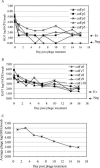Application of bacteriophages to control intestinal Escherichia coli O157:H7 levels in ruminants
- PMID: 16885287
- PMCID: PMC1538718
- DOI: 10.1128/AEM.00099-06
Application of bacteriophages to control intestinal Escherichia coli O157:H7 levels in ruminants
Abstract
A previously characterized O157-specific lytic bacteriophage KH1 and a newly isolated phage designated SH1 were tested, alone or in combination, for reducing intestinal Escherichia coli O157:H7 in animals. Oral treatment with phage KH1 did not reduce the intestinal E. coli O157:H7 in sheep. Phage SH1 formed clear and relatively larger plaques on lawns of all 12 E. coli O157:H7 isolates tested and had a broader host range than phage KH1, lysing O55:H6 and 18 of 120 non-O157 E. coli isolates tested. In vitro, mucin or bovine mucus did not inhibit bacterial lysis by phage SH1 or KH1. A phage treatment protocol was optimized using a mouse model of E. coli O157:H7 intestinal carriage. Oral treatment with SH1 or a mixture of SH1 and KH1 at phage/bacterium ratios > or = 10(2) terminated the presence of fecal E. coli O157:H7 within 2 to 6 days after phage treatment. Untreated control mice remained culture positive for >10 days. To optimize bacterial carriage and phage delivery in cattle, E. coli O157:H7 was applied rectally to Holstein steers 7 days before the administration of 10(10) PFU SH1 and KH1. Phages were applied directly to the rectoanal junction mucosa at phage/bacterium ratios calculated to be > or = 10(2). In addition, phages were maintained at 10(6) PFU/ml in the drinking water of the phage treatment group. This phage therapy reduced the average number of E. coli O157:H7 CFU among phage-treated steers compared to control steers (P < 0.05); however, it did not eliminate the bacteria from the majority of steers.
Figures



References
-
- Allerberger, F., M. Wagner, P. Schweiger, H. P. Rammer, A. Resch, M. P. Dierich, A. W. Friedrich, and H. Karch. 2001. Escherichia coli O157 infections and unpasteurised milk. Euro Surveill. 6:147-151. - PubMed
-
- Bach, S. J., T. A. McAllister, D. M. Veira, V. P. J. Gannon, and R. A. Holley. 2003. Effect of bacteriophage DC22 on Escherichia coli O157:H7 in an artificial rumen system (Rusitec) and inoculated sheep. Anim. Res. 52:89-101.
-
- Beighton, D., K. Smith, D. A. Glenister, K. Salamon, and C. W. Keevil. 1988. Increased degradative enzyme production by dental plaque bacteria in mucin-limited continuous culture. Microb. Ecol. Health Dis. 1:85-94.
-
- Bell, B. P., M. Goldoft, P. M. Griffin, M. A. Davis, D. C. Gordon, P. I. Tarr, C. A. Bartleson, J. H. Lewis, T. J. Barrett, J. G. Wells, et al. 1994. A multistate outbreak of Escherichia coli O157:H7-associated bloody diarrhea and hemolytic uremic syndrome from hamburgers. The Washington experience. JAMA 272:1349-1353. - PubMed
Publication types
MeSH terms
Grants and funding
LinkOut - more resources
Full Text Sources
Other Literature Sources

